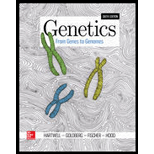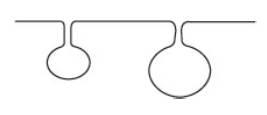
Genetics: From Genes To Genomes (6th International Edition)
6th Edition
ISBN: 9781260041217
Author: Leland Hartwell Dr., ? Michael L. Goldberg Professor Dr., ? Janice Fischer, ? Leroy Hood Dr.
Publisher: Mcgraw-Hill
expand_more
expand_more
format_list_bulleted
Concept explainers
Textbook Question
thumb_up100%
Chapter 6, Problem 10P
When a double-stranded DNA molecule is exposed to high temperature, the two strands separate, and the molecule loses its helical form. We say the DNA has been denatured. (Denaturation also occurs when DNA is exposed to acid or alkaline solutions.)
| a. | Regions of the DNA that contain many A–T base pairs are the first to become denatured as the temperature of a DNA solution is raised. Thinking about the chemical structure of the DNA molecule, why do you think the A–T-rich regions denature first? |
| b. | If the temperature is lowered, the original DNA strands can reanneal, or renature. In addition to the full double-stranded molecules, some molecules of the type shown here are seen when the molecules are examined under the electron microscope. How can you explain these structures? |

Expert Solution & Answer
Want to see the full answer?
Check out a sample textbook solution
Students have asked these similar questions
not use ai please
DNK dagi nukleotidlar va undan sintezlangan oqsildagi peptid boglar farqi 901 taga teng bo'lib undagi A jami H boglardan 6,5 marta kam bo'lsa DNK dagi jami H bog‘lar sonini toping
One of the ways for a cell to generate ATP is through the oxidative phosphorylation. In oxidative phosphorylation 3 ATP are produced from every one NADH molecule. In respiration, every glucose molecule produces 10 NADH molecules. If a cell is growing on 5 glucose molecules, how much ATP can be produced using oxidative phosphorylation/aerobic respiration?
Chapter 6 Solutions
Genetics: From Genes To Genomes (6th International Edition)
Ch. 6 - Griffith, in his 1928 experiments, demonstrated...Ch. 6 - Griffith, in his 1928 experiments, demonstrated...Ch. 6 - During bacterial transformation, DNA that enters a...Ch. 6 - Nitrogen and carbon are more abundant in proteins...Ch. 6 - If 30 of the bases in human DNA are A, a what...Ch. 6 - Which of the following statements are true about...Ch. 6 - Imagine you have three test tubes containing...Ch. 6 - What information about the structure of DNA was...Ch. 6 - A portion of one DNA strand of the human gene...Ch. 6 - When a double-stranded DNA molecule is exposed to...
Ch. 6 - A particular virus with DNA as its genetic...Ch. 6 - The underlying structure of DNA is very simple,...Ch. 6 - Prob. 13PCh. 6 - Bacterial transformation and bacteriophage...Ch. 6 - The CAP protein is shown bound to DNA in Fig....Ch. 6 - In Meselson and Stahls density shift experiments...Ch. 6 - When Meselson and Stahl grew E. coli in 15N medium...Ch. 6 - If you expose human tissue culture cells for...Ch. 6 - Draw a replication bubble with both replication...Ch. 6 - a. Do any strands of nucleic acid exist in nature...Ch. 6 - As Fig. 6.21 shows, DNA polymerase cleaves the...Ch. 6 - The bases of one of the strands of DNA in a region...Ch. 6 - Replicating structures in DNA can be observed in...Ch. 6 - Indicate the role of each of the following in DNA...Ch. 6 - Draw a diagram of replication that is occurring at...Ch. 6 - Figure 6.18 depicts Watson and Cricks initial...Ch. 6 - Researchers have discovered that during...Ch. 6 - A DNA synthesizer is a machine that uses automated...Ch. 6 - Bacterial cells were coinfected with two types of...Ch. 6 - A yeast strain with a mutant spo11- allele has...Ch. 6 - Imagine that you have done a cross between two...Ch. 6 - The Neurospora octad shown came from a cross...Ch. 6 - From a cross between e f g and e f g strains of...Ch. 6 - In Step 6 of Fig. 6.27, the resolvase enzyme...Ch. 6 - Figure 6.31shows four potential outcomes of...Ch. 6 - Each of the substrates for site-specific...Ch. 6 - Prob. 37PCh. 6 - Suppose that you could inject a wild-type mouse...Ch. 6 - C31 is a type of bacteriophage that infects...Ch. 6 - Cre is a recombinase enzyme encoded by a gene in...Ch. 6 - Like Cre/loxP recombination, site-specific...
Knowledge Booster
Learn more about
Need a deep-dive on the concept behind this application? Look no further. Learn more about this topic, biology and related others by exploring similar questions and additional content below.Similar questions
- Answer in step by step with explanation. Don't use Ai and chatgpt.arrow_forwardIdentify the indicated cavity (Fucus). a. antheridia b. conceptacel c. receptacle d. oogonium e. none of thesearrow_forwardIdentify the indicated structure (Saprolegnia). a. antheridium O b. oospore c.sperm d. auxospore e. tetraspore Of. zygosporearrow_forward
- Using information from the primary literature (several references have been provided as a starting point below) please answer the following question: Based on your review of the literature on rewilding, what are the major scientific pros and cons for rewilding? Please note that the focus of this assignment are the (biological) scientific issues associated with rewilding. As will be discussed in class, there are a number of non-scientific issues involved or implicated in rewilding, all ultimately affecting the public acceptability of rewilding. Although these issues are important – indeed, critical – in this assignment you should focus on the biological science issues and questions. Details: You must enumerate at least two pros and at least two cons. Your answer should be no more than 500 well-chosen words, excluding references. Think carefully about how best to organize and structure your answer. Aim for high information density: say a lot, but say it succinctly. Recall Nietzche’s…arrow_forwardUsing information from the primary literature (several references have been provided as a starting point below) please answer the following question: Based on your review of the literature on rewilding, what are the major scientific pros and cons for rewilding? Please note that the focus of this assignment are the (biological) scientific issues associated with rewilding. As will be discussed in class, there are a number of non-scientific issues involved or implicated in rewilding, all ultimately affecting the public acceptability of rewilding. Although these issues are important – indeed, critical – in this assignment you should focus on the biological science issues and questions. Details: You must enumerate at least two pros and at least two cons. Your answer should be no more than 500 well-chosen words, excluding references. Think carefully about how best to organize and structure your answer. Aim for high information density: say a lot, but say it succinctly. Recall Nietzche’s…arrow_forwardNow draw a rough sketch of what the control data might look like if in addition to the specific binding, there was also a considerable amount of nonspecific binding (again using a normal dose/response curve) (do % total bound ligand vs concentration)arrow_forward
- What are functions of cuboidal cells in the kidney? Select all that apply. Concentration of gases Dilution of chemicals Secretion of molecules Nutrition to tissues Support of tissues Absorption of moleculesarrow_forwardquestion1 In plants, epithelial tissue is only found as the outermost cell layer and acts as a barrier. In humans, epithelial tissue is found inside the body as well as on the surface. What function(s) does/do epithelial tissue carry out in humans? Select all that apply. Waste storage Filtration Oxygen transport Protection Diffusion Osmosis Absorptionarrow_forwardWhat words best describes this organism? a. Unicellular/nonmotile Ob. unicellular/motile c. colonial/nonmotile d. colonial/motile e. multicelluar O f. siphonous g. none of thesearrow_forward
arrow_back_ios
SEE MORE QUESTIONS
arrow_forward_ios
Recommended textbooks for you
 Human Heredity: Principles and Issues (MindTap Co...BiologyISBN:9781305251052Author:Michael CummingsPublisher:Cengage Learning
Human Heredity: Principles and Issues (MindTap Co...BiologyISBN:9781305251052Author:Michael CummingsPublisher:Cengage Learning Concepts of BiologyBiologyISBN:9781938168116Author:Samantha Fowler, Rebecca Roush, James WisePublisher:OpenStax College
Concepts of BiologyBiologyISBN:9781938168116Author:Samantha Fowler, Rebecca Roush, James WisePublisher:OpenStax College Biology Today and Tomorrow without Physiology (Mi...BiologyISBN:9781305117396Author:Cecie Starr, Christine Evers, Lisa StarrPublisher:Cengage Learning
Biology Today and Tomorrow without Physiology (Mi...BiologyISBN:9781305117396Author:Cecie Starr, Christine Evers, Lisa StarrPublisher:Cengage Learning Anatomy & PhysiologyBiologyISBN:9781938168130Author:Kelly A. Young, James A. Wise, Peter DeSaix, Dean H. Kruse, Brandon Poe, Eddie Johnson, Jody E. Johnson, Oksana Korol, J. Gordon Betts, Mark WomblePublisher:OpenStax College
Anatomy & PhysiologyBiologyISBN:9781938168130Author:Kelly A. Young, James A. Wise, Peter DeSaix, Dean H. Kruse, Brandon Poe, Eddie Johnson, Jody E. Johnson, Oksana Korol, J. Gordon Betts, Mark WomblePublisher:OpenStax College BiochemistryBiochemistryISBN:9781305577206Author:Reginald H. Garrett, Charles M. GrishamPublisher:Cengage Learning
BiochemistryBiochemistryISBN:9781305577206Author:Reginald H. Garrett, Charles M. GrishamPublisher:Cengage Learning

Human Heredity: Principles and Issues (MindTap Co...
Biology
ISBN:9781305251052
Author:Michael Cummings
Publisher:Cengage Learning

Concepts of Biology
Biology
ISBN:9781938168116
Author:Samantha Fowler, Rebecca Roush, James Wise
Publisher:OpenStax College

Biology Today and Tomorrow without Physiology (Mi...
Biology
ISBN:9781305117396
Author:Cecie Starr, Christine Evers, Lisa Starr
Publisher:Cengage Learning

Anatomy & Physiology
Biology
ISBN:9781938168130
Author:Kelly A. Young, James A. Wise, Peter DeSaix, Dean H. Kruse, Brandon Poe, Eddie Johnson, Jody E. Johnson, Oksana Korol, J. Gordon Betts, Mark Womble
Publisher:OpenStax College

Biochemistry
Biochemistry
ISBN:9781305577206
Author:Reginald H. Garrett, Charles M. Grisham
Publisher:Cengage Learning

Macromolecules | Classes and Functions; Author: 2 Minute Classroom;https://www.youtube.com/watch?v=V5hhrDFo8Vk;License: Standard youtube license